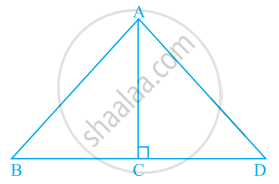Advertisements
Advertisements
प्रश्न
The two opposite vertices of a square are (− 1, 2) and (3, 2). Find the coordinates of the other two vertices.
उत्तर

Let ABCD be a square having (−1, 2) and (3, 2) as vertices A and C respectively. Let (x, y), (x1, y1) be the coordinate of vertex B and D respectively.
We know that the sides of a square are equal to each other.
∴ AB = BC
`=>sqrt((x+1)^2 + (y-2)^2) = sqrt((x-3)^2 + (y-2)^2)`
=>x2 + 2x + 1 + y2 -4y + 4 = x2 + 9 -6x + y2 + 4 - 4y
⇒ 8x = 8
⇒ x = 1
We know that in a square, all interior angles are of 90°.
In ΔABC,
AB2 + BC2 = AC2
`=> (sqrt(((1+1)^2)+(y-2)^2))^2 + (sqrt(((1-3)^2)+(y-2)^2))^2 = (sqrt((3+1)^2+(2-2)^2))^2`
⇒ 4 + y2 + 4 − 4y + 4 + y2 − 4y + 4 =16
⇒ 2y2 + 16 − 8 y =16
⇒ 2y2 − 8 y = 0
⇒ y (y − 4) = 0
⇒ y = 0 or 4
We know that in a square, the diagonals are of equal length and bisect each other at 90°. Let O be the mid-point of AC. Therefore, it will also be the mid-point of BD
Coordinate of point O = ((-1+3)/2, (2+2)/2)
`((1+x_1)/2, (y+ y_1)/2) = (1,2)`
`(1+x_1)/2 = 1`
1+x1=2
x1 =1
and
` (y + y_1)/2 = 2`
⇒ y + y1 = 4
If y = 0,
y1 = 4
If y = 4,
y1 = 0
Therefore, the required coordinates are (1, 0) and (1, 4).
APPEARS IN
संबंधित प्रश्न
A(4, - 6), B(3,- 2) and C(5, 2) are the vertices of a 8 ABC and AD is its median. Prove that the median AD divides Δ ABC into two triangles of equal areas.
Find values of k if area of triangle is 4 square units and vertices are (k, 0), (4, 0), (0, 2)
Four points A (6, 3), B (−3, 5), C(4, −2) and D (x, 3x) are given in such a way that `(ΔDBG) /(ΔABG)=1/2,` find x
Find a relation between x and y, if the points A(x, y), B(-5, 7) and C(-4, 5) are collinear.
Points A(3, 1), B(12, –2) and C(0, 2) cannot be the vertices of a triangle.
If `D((-1)/2, 5/2), E(7, 3)` and `F(7/2, 7/2)` are the midpoints of sides of ∆ABC, find the area of the ∆ABC.
Find the values of k if the points A(k + 1, 2k), B(3k, 2k + 3) and C(5k – 1, 5k) are collinear.
In the given figure, ratio of the area of triangle ABC to the area of triangle ACD is the same as the ratio of base BC of triangle ABC to the base CD of ΔACD.

If (a, b), (c, d) and (e, f) are the vertices of ΔABC and Δ denotes the area of ΔABC, then `|(a, c, e),(b, d, f),(1, 1, 1)|^2` is equal to ______.
Find the missing value:
| Base | Height | Area of Triangle |
| 22 cm | ______ | 170.5 cm2 |
